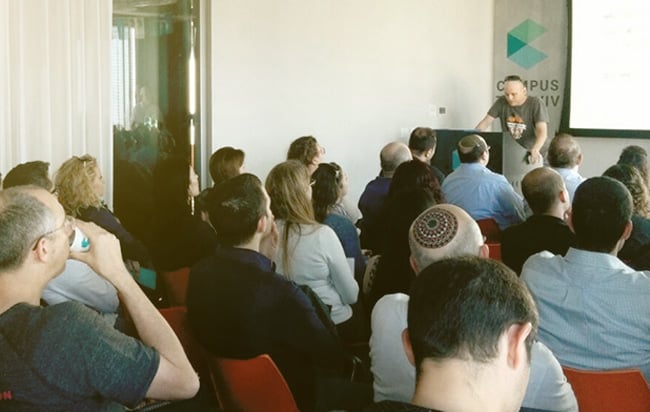
On March 30th, the gorgeous Google Campus in Tel Aviv was jammed packed with over 70 inbound marketing professionals, industry experts, and marketing enthusiasts. It was an evening of networking, professional betterment and lots of fun!
We heard from top B2B inbound marketing experts on content, lead nurturing, marketing automation workflows, and revenue operations optimization (RevOps). Looking around the room, I saw the attendees soaking up the creative and practical recommendations while snapping pictures of the presenters’ slides to have a record for future reference.
The lineup of speakers included allstars Asaph Schulman, Clare Avieli, and Resa Gooding-Eshed. In case you missed it, here’s my take on the best practices and key takeaways:
Asaph Schulman: How We Used Mini Sites to Battle Mega Competition
Asaph Schulman is the VP Marketing for Checkmarx. Asaph explained at our HubSpot User Group different tactics and campaigns that can help the little guys to compete with mega competitors. If you want to stand a chance against gigantic competitors, bear these tips in mind:
Ride Trend Waves
In order to connect with your target audience, make it a priority to monitor new trends and adapt them to your own niche. There are always new trends, so use them to your advantage and “ride the wave”. Here’s an example of what Asaph created when the “What they think I do” meme was taking over our newsfeeds.

This is a great example of a cheap yet effective way to connect with your target audience, make them laugh, and increase your brand awareness. Don’t forget to be fleet enough of foot to promote trends when they’re still cool. Otherwise, you’ll look old and outdated. Sorry, the truth hurts!
Crowdsource Everything You Can
When creating your next marketing campaign, don’t underestimate the power of crowdsourcing. Crowdsourcing is a great way to spark healthy competition, engage with customers, and create a strong online presence. Best of all, it’s simple!
Asaph explained how Checkmarx created an online forum and asked: “What tips can you offer to achieve greater app security in 2016?” To sweeten the pot, Checkmarx promised the commenter who receives the most upvotes an AR Drone as a prize.
All they did was create a discussion on WordPress, and asked people to give their tips. To say it worked well is an understatement. It was extremely successful because he gained a whole new outlook on what his customers were thinking, got hundreds of leads – 40 qualified leads – a handful of customers, and a lot of positive attention.
Crowdsourcing gets people excited, and sparks their competitive side. It causes people to share your site internally, since they want to get as many “upvotes” as possible. Genius! And why do people want upvotes? Because of the sweetener, of course! That little bit of incentive is the lynchpin that got the whole project moving. Truly, it’s the small things in life that count.
Always Observe Your Surroundings:
Whenever you’re at a conference or tradeshow, take a moment to observe your surroundings. Tradeshows are a great opportunity for concentrated customer interactions. You can get a lot of marketing campaign ideas by just looking at your target audience and observing them.
Asaph observed his target audience at a tradeshow, realized a great potential idea, and created a marketing campaign around it. In the specific example Asaph gave, that campaign actually gave way to a successful product offering. All from observing!
Here’s what happened: When Asaph was at a tradeshow, he saw a bunch of people staring at a wall, arguing about something unknown to him. He could have just walked away, but he realized that somewhere on that wall there was something captivating his target audience. Naturally, he wanted to find out what that was.
As it turns out, it was a piece of paper with a lot of code, beneath which was written in big red letters: “Find the vulnerability”. There was no incentive, no prize, nothing driving these people into a heated conversion other than their sincere interest in coding and solving problems.

As he retold it, Asaph thought to himself: “How can we replicate and leverage this behavior?” He created a marketing campaign which turned into a game called Game of Hacks, which was designed to test your application hacking skills. In the first 24 hours, there were 35,0000 players, 1,000 of those visitors found their way over to Checkmarx.com. As a result, he generated significant leads, got excellent reviews and feedback from customers, and had huge press coverage.
Takeaway tip: Find out what your customers are interested in, and leverage it.
Interact with Industry Thought Leaders
Whenever you have a new product or campaign, reach out to industry experts and either give them a free version or ask for their feedback. They’re humans just like you and me, and will be flattered to give their opinion and happy to receive free swag.
If you reach out to them through social media, they’ll probably take a picture and thank you. Think about how much social traffic and increased brand awareness that can create!
Tip: Approach industry thought leaders with something valuable and they’ll always be happy to share.
Clare Avieli: 7 Ways to Create Killer Content
Clare is the Director of Content Marketing at BlazeMeter. She discussed many ways to create great content – even when you have no idea what you’re talking about. Most marketers have realistically encountered this problem, so was an especially well-received presentation.
1. Use Online Tools
You just started working at a new company and you don’t really understand the industry. What do you do? You should obviously start researching your own company’s resources such as the website, whitepapers, blogs, infographics etc.
After that, there are many tools to help you better understand your industry and come up with new content ideas.
- Google Alerts: This is a great way to start. Get all your top keywords, set up alerts, and you’ll get a daily, weekly, or monthly digests of content on the web pertaining to the selected keywords. You’ll be able to monitor what people are talking about, get updates on interesting topics and help with your content ideation.
- BuzzSumo: This is like Google Alerts but just more advanced. It allows you to get more granular content alerts, find the most successful content on the web, and see what your competitors are doing.
- Portent’s Content Idea Generator: This tool helps you come up with a new perspective and different take on your content – and sometimes that’s really all you need. With this tool you can input a keyword and it gives you ideas for an article. Think about how this fresh take can help you create new blog posts.
2. Be the Company Journalist
What’s the best way to generate content? Use the knowledge of your colleagues!
If you work in the tech world, many colleagues that surround you are also your target audience. Make sure to set brainstorming sessions with relevant people and “use” them to learn more about your industry and potential customers.
How do you get them on board? Make yourself the journalist – tell them you want to chat for half an hour AND DON’T TELL THEM you want to write a blog. Decide on the topic before and ask relevant questions. Once you write up the blog post, make sure to give them all the credit.
Offer an incentive – You don’t want to “pay off your colleagues” but offering a reward based on content results is a good way to get colleagues involved. A bit of healthy workplace competition never killed anyone… except for that one time.
3. Sit with Sales & Support
This is different than being the company journalist. Here you should regularly join the sales and support team, as a silent observer on their calls. Take note of the top needs, reoccurring problems and constant requests. This will help you learn about your customers, helping you to create content that will convert.
Write down every question that your customers are asking, and turn each one into a “How To” blog post. Easy yet affective!
When you’re sitting in with the sales team, listen to the specific features and services that most interest your customers. Once you do this, the guessing game is over – you’ll create content that actually interests them.
4. Repurpose
Don’t forget about all of your existing content. Look back at your best performing content and ask yourself: Has anything changed? Can I take a different angle? Can I follow up?
Do:
- Use Your Own Blog
- Use Google Analytics – To pinpoint content worth repurposing
- Use BuzzSumo – See what articles are popular and create a new angle
- Use Trending Articles – Find the top articles written in a specific topic and create content around it
- Use Current Events
- Create Multiple Content Pieces from Only One Story Idea
As Clare wisely said: “Find a new angle to existing articles.” Once you do that, you can create 10 or 20 pieces of content all from one story idea. It’s as simple as that!
Resa Gooding: What’s Really Happening to Those Leads?
Resa is the Director of Marketing at OpenLegacy. Since all inbound marketers stress the importance of leads and promise to produce more leads, many are faced with the common struggle of actually making this promise come to fruition.
Resa took this common challenge and gave many insights on how to pinpoint your leads and move your customers further down the funnel in a systematic and efficient way. Here are some key takeaways:
First you have to ask yourself, where are my leads? You may think that they’re with sales, in HubSpot or even left in Salesforce. The truth is, they’re lost in the pipeline! We usually don’t know where our leads are, and therefore aren’t following up with them. That’s mistake #1!
In order to fully understand what’s really happening with your leads, you need to keep the following points in mind:
Why Are Your Leads Getting Lost?
Before you can understand how to properly engage with your leads, you need to pinpoint where exactly they are.
Start by asking yourself: Am I properly scoring my leads? Most leads are lost because it’s unclear what stage your leads are in.
Resa gave a great list of different reasons why your leads get lost. Take a look below.
All of the reasons pictured here apply to a majority of marketers. Go through everyone of these points and create your own checklist. Work on the points that apply to you, and you’ll be one step closer to locating your leads.
The Real Problem
As Resa astutely pointed out, the real problem with locating your leads is: how can leads be relevant to a buyer’s stage when you don’t know where they stand in their journey? For example, if you get a cold database from a conference, there’s no real way to know what stage each lead is in, therefore making it extremely hard to handle each lead properly.
What’s the solution? Send a nurture email to the entire database, treating the recipients as if they were bottom of the funnel leads. Those that aren’t really decision-ready will disregard the email, but the subsection that is will be driven further into your arms and primed for conversion. This enables highest return possible in the shortest amount of time.
After you receive responses from those that emerge as bottom of the funnel leads, you can go back and begin nurturing the remainder with awareness and consideration stage materials.
We’re All Pretty Overwhelmed as Marketers
There’s another reason why leads get lost – we’re overwhelmed as marketers! If your to-do-list is jammed packed, there’s something that needs to change. Take ownership of the projects that are most important, outsource any possible tasks, and automate everything else. It might sound simple, but Resa says that it really works – so give it a try!
After having the privilege to attend our recent HubSpot User Group, and hear such inspiring B2B marketers, I have no doubt that these tips will help me and other attendees become better marketers in the future. I’m already anxious for our next HubSpot User Group and look forward to hearing more actionable tips! I hope to see you all there.
Before you can begin the lead scoring process, you must understand the different elements that influence how you score a lead. Download this free guide to learn more.

by The Penguin Team on April 06, 2016
As a leading B2B digital marketing agency, We help B2B Technology Companies, enterprise software, and hardware companies increase brand awareness, reach more qualified leads and close more customers. Penguin Strategies is a Diamond Partner of HubSpot.





